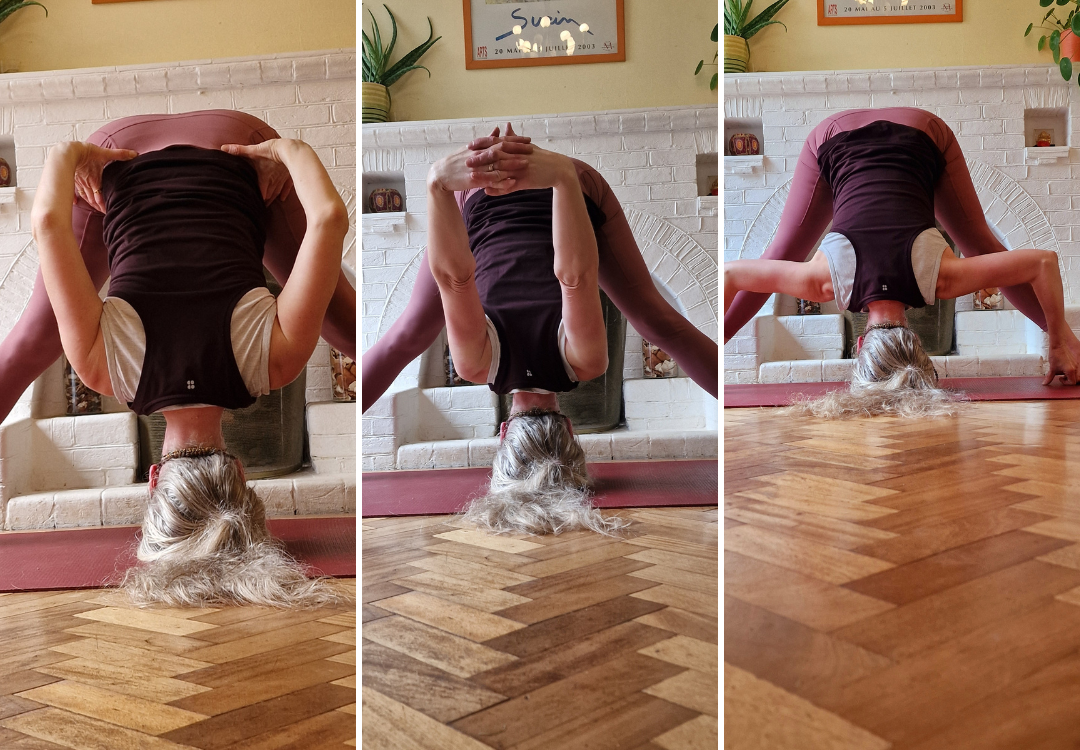How to Practise Prasarita Padottanasana (Wide-Legged Forward Bend)
Wide-legged forward bend, or Prasarita Padottanasana, is one of my favourite poses. It took me a few years to master, and now I love it.
In the standing sequence of ashtanga yoga Prasarita Padottanasana follows the side bends of the triangle and side angle pose, bringing back a sense of centring after moving away from the centre.
Indeed, the pose requires length through the hamstrings, inner thighs, lower back and hips. This deep forward bend allows the spine to lengthen naturally with the help of gravity, opening the intervertebral spaces a little more and relaxing the brain and nervous system.
How to practise Prasarita Padottanasana
Step out into a middle wide stance from the top of your mat, and align the outside of the feet parallel with the outside of your mat.
Place hands on the pointy hip bones, IN lengthens into the spine, EX, soften your knees and fold forward from your hips.
Keep knees bent as needed; hands can be placed on the thighs, knees, or on the floor in front of you.
IN peel the upper body away from the legs into half a forward bend.
EX fold forward again and draw your navel gently back towards the spine.
Draw your legs toward each other and up into the hip joint to create a strong foundation. Next, lengthen the crown of your head towards the floor.
Each in-breath reinforces the foundation of the legs. Each outbreath lengthens the spine, with the crown of the head drawing down to the ground.
Stay for five long breaths.
To exit the pose with an in-breath, come back into half forward bend, take your hands on hips or the thighs, and stay for the outbreath; with the following in-breath, bend your knees, and sit back slightly to come up standing by straightening your legs.
Are there any further Benefits?
Apart from the benefits mentioned earlier, it is also excellent for our digestion. Both BKS Iyengar and Pattabhi Jois revered Prasarita Padottanasana for this very reason.
BKS Iyengar mentioned that, apart from the benefits on hamstrings and inner thighs, Prasarita Padottanasana increases digestive powers. Furthermore, he suggests a wide-legged forward bend as an alternative if a headstand is not accessible. Jois sees it as purifying the anal canal. As a result, it dissolves bad fat in the lower abdomen, cures constipation, and purifies the top part of the spinal column.
How to make the Pose more accessible
Working with the big muscle groups of the hamstring and the inner thighs is challenging and requires patience.
Here are a few tips on how to slowly master the pose over time.
As mentioned above, bend your knees as needed, and work with your breath. Send each in-breath into the areas where it feels short and tight. Then, in your mind’s eye, see these areas lengthen and soften. When you feel a release in the muscles, straighten the legs a little more.
Use a chair with your hands or elbows on the chair. Work with the legs in the same way as before.
Use 2 blocks to place your hands on once the muscles have lengthened a little more, and continue working with your breath.
You can use the wall, with the sit bones against it, walking them up the wall as the hamstrings and inner thighs lengthen.
How to challenge yourself in Prasarita Padottanasana?
Ashtanga Yoga offers 4 different versions of the wide-legged forward bend. All are related to the positions of the arms. The different arm positions require us to work with our strength rather than allowing us to pull ourselves down. They are
with the hands on the floor as above.
hands are on the hips.
hands are interlaced behind the back.
thumbs and index fingers are hooked around the big toes.
Many Yoga asanas have a beneficial effect on our digestive system. If our digestive system is healthy, we are healthy and vice versa.
Prasarita Padottanasana strongly supports our digestive system, and for that reason, it is worth persevering. Apart from the feeling of lightness and calm.
Do you like practising this pose? Email me back and let me know.

